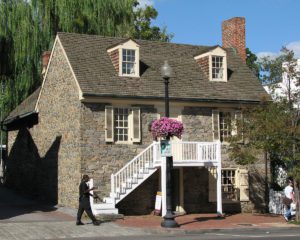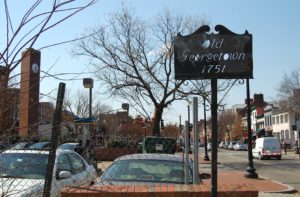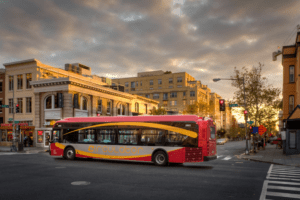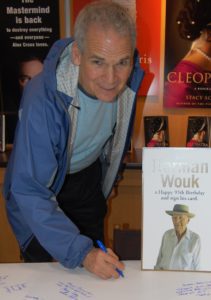Town Topics Oct. 25, 2017
By • October 25, 2017 0 456

By Peggy Sands and Robert Devaney
Halcyon Introduces First Arts Lab Fellows
On Oct. 16, Georgetown-based Halcyon, which evolved from S&R Foundation and began operating independently this year, introduced its inaugural cohort of arts fellows at the new Halcyon Art Lab, located in the former Fillmore School on 35th Street. The nonprofit organization “supports talented individuals with great potential and high aspirations in science, art and social entrepreneurship.”
“We are honored to help these artists shine a spotlight on some of the greatest truths and fears that we, as a society, struggle to confront and address,” said Kate Goodall, CEO of Halcyon. “I look forward to seeing how each artist reaches their potential, and how their art helps to shape the larger cultural narratives that surround these critical issues.”
This initial Arts Lab cohort includes six national and two international fellows. They are given stipends (around $10,000 each) to support living and material expenses for nine months, plus housing in a newly renovated residence nearby. Each fellow makes use of a studio workspace suitable to the fellow’s proposed project. As a group, they are provided with a curriculum of practical classes and talks from visiting artists and civic leaders, mentorship and critiques from experienced arts professionals and opportunities to collaborate with fellow artists, social entrepreneurs and Halcyon partner organizations.
In turn, the cohort mentors eight local emerging young artists selected from a competitive application process. Initially coming from three low-income wards in Washington, D.C., each emerging artist receives a grant of $1,000.
Many of the projects of the Arts Lab fellows deal with issues of immigration, xenophobia and discrimination. According to their bios and interviews at the launch event, they include a “textile design thinker highlighting immigrant narratives and collective culture” who is confronting her own experience with violent anti-Semitism in France, a “hand-cut paper and textile artist empowering queer and trans people of color” and a “performative sculpture artist investigating alien tropes and combating xenophobia.”
Others include a “sculpture and storyteller changing societal perceptions of black identity,” a “photographer seeking to restore missing violent histories, namely actions surrounding the Argentine Dirty War,” a “creator of interactive installations designed to investigate feminine mythology rituals and sacred spaces” and a “performance-based artist reimaging and reframing American childhood pedagogy.”
Major sponsors and donors of Halcyon Arts Lab include TTR/Sotheby’s, the Bernstein Family Foundation, the Carl M. Freeman Foundation, U.S. Trust and DC Prep.
Georgetown U. Gears Up to Protect DREAMers
Congress has until mid-March to agree on legislation that would give legal status to at least some of the 800,000 millennials who entered the country illegally before the age of 16 and had been granted a temporary deferment from deportation — as well as a temporary work permit — under an executive order by President Barack Obama in 2012. President Donald Trump rescinded the order known as DACA (Deferred Action for Childhood Arrivals), to take effect as of March 2018.
One of the requirements to qualify for DACA status was to be accepted into college, to be currently attending or to have graduated. About 30,000 DACA recipients (aka DREAMers) are estimated to have enrolled in college this summer, reported advocacy group Generation Progress at the Center for American Progress on Oct. 19. “Of those, just 2000 graduate from college each year,” according to Generation Progress.
The organization, which is calling for “All colleges and universities [to] enact policies to fully open the gates of higher education to undocumented students,” is recommending the implementation of key best practices, including guaranteed housing, offers of financial aid, confidentiality and safeguards from immigration enforcement such as prohibiting police and immigration forces from entering campus buildings to stop or question undocumented students.
Most urgently, Generation Progress and other advocates are pushing for colleges to provide in-depth counseling services specific to DACA recipients and other students in the country illegally. Arelis Palacios provides such services for unauthorized students at Georgetown University. She is associate director for undocumented student services at the Center for Multicultural Equity & Access and director of group initiatives in the Division of Student Affairs.
Last year, student activists told The Georgetowner that their services for undocumented students also included “undocumented” campus personnel and faculty. “Don’t believe everything students say,” said Palacios with a laugh. “Georgetown University has a strict policy of not hiring those without legal work permits.”
The campus also has a policy of not asking any student or applicant about his or her immigration status, Palacios said. But she declined to say how many unauthorized students she serviced, how many were at the University and if the number had increased. “That is private information,” she said.
Old Stone House to Close for More Than a Year

The Old Stone House. Photo by Hu Totya.
On Oct. 30, the Old Stone House, located at 3051 M St. NW, will close for more than a year — through Dec. 1, 2018 — for the installation of a new fire-suppression system and structural rehabilitation work, according to the National Park Service.
For the upcoming work, the Park Service has shortened visiting times to one of D.C.’s oldest buildings. Through Oct. 29, hours will be 11 a.m. to 3:45 p.m., Wednesday through Sunday.
A ranger will explain the different aspects of the work on the home. NPS adds: “Museum collection items have been relocated to a climate-controlled facility and will be returned when construction is complete.”
The following is background information from the Park Service: The Old Stone House, constructed circa 1765, is one of the oldest buildings in Washington, D.C. The desire to honor and remember George Washington combined with fuzzy memories led to the Old Stone House’s preservation, while so much changed around it. People believed the Old Stone House to be the location of an inn — Suter’s Tavern, named after its owner, John Suter — where George Washington and city planner Pierre L’Enfant stayed when they met to survey the newly established District of Columbia. In reality, Washington and L’Enfant stayed in Georgetown’s Fountain Inn at 31st and K Streets NW. In the (now) Old Stone House, located on Bridge Street (now M Street NW), John Suter’s son, John, Jr., ran a clock shop. The two men with the same name and two nearby locations led to the case of mistaken identity.
The house was the site of a car dealership when the federal government purchased the property in 1953. The National Park Service opened the house to the public in 1960. Today, the house is a rare example of pre-Revolutionary architecture. A clock built by one-time owner John Suter, Jr., is part of the Old Stone House furnishings.

The last Georgetown sign as it stands today on the eastern entrance on M Street. Georgetowner photo.
Georgetown Gateways Project Underway
“Gateway décor that will herald the four different entrances to Georgetown already have gone through several rounds in the planning process,” Jamie Scott, economic development manager of the Georgetown Business Improvement District, said in a phone interview Oct. 20. “Some plans may be ready for a first public review by early next year.”
“Even as there will be consistency in perhaps color or surface elements of the
entrance décor, it also will be flexible and respond to fit the physical environment and visual requirements of each site,” Scott said. “For instance, the K Street entrance is a high- traffic area under a freeway. M Street and Pennsylvania and the Key Bridge entrances approach Georgetown from scenic bridges. Wisconsin and R is at the top of Book Hill and amidst Upper Georgetown shops, businesses and the Duke Ellington Performing Arts School with at times busy pedestrian traffic. Gateway designs will be reflective of those differences.”
A “kit of parts” has been developed in which each element can be adapted to individual sites. These include the size and character of the entrance signs and, in some pedestrian areas, wayfinding signs. There will also be flexibility in sculpting the entrance element and in the mix of public and private spaces.
Many community and government organizations have been involved in the design process to date, according to Scott. These include the advisory neighborhood commission, the Citizens Association of Georgetown, the U.S. Commission of Fine Arts, the District Department of Transportation and the National Park Service.
 DC Circulator: To Stop or Not to Stop?
DC Circulator: To Stop or Not to Stop?
District Department of Transportation officials seem to be having a Hamlet moment when it comes to the Circulator bus in Georgetown: To stop or not to stop, that is the question.
It has to do with the Georgetown to Union Station route along Wisconsin Avenue and M Street. The Circulator was supposed to be the fast, don’t-stop-every-block bus along M and K Streets and eventually Massachusetts Avenue to the station and the Senate side of the Capitol. It was supposed to only make four stops per mile. (The D6 goes to Union Station on a circuitous route down Wisconsin Avenue to Q Street in Georgetown to Dupont Circle. Various other buses run the length of Wisconsin Avenue.)
But things changed. The big comfortable bus now makes seven stops in Georgetown each way: 5.2 stops per mile eastbound and 4.5 stops per mile westbound. Riders have
complained that it’s too slow and ridership started to drop. The ANC had to fight to keep the route along Wisconsin Avenue running at all.
Now the DDOT board is pondering cutting out stops along Wisconsin Avenue — both ways at R, Q and/or P Streets. At its Oct. 2 meeting, the ANC unanimously opposed any changes in Georgetown (four changes outside of Georgetown are also being proposed).
Some point out that the real place the Circulator slows down is on Wisconsin from the waterfront up to M Street, where it lumbers along. Traffic flow on that long block with a mid-block traffic signal has been under review for the past year.
Heating Plant May Be Named Historic Landmark

The West Heating Plant on 29th Street as it looks today. Georgetowner photo.
D.C.’s Historic Preservation Office will recommend to its Review Board on Nov. 2 that the West Heating Plant at 1051-1055 29th St. NW be designated a historic landmark and be placed in the D.C. Inventory of Historic Sites, according to a document released to the press on Oct. 27. It will also request that the site nomination be forwarded to the National Register of Historic Places for listing as “of local significance — if the property owner does not still object to that listing.”
The approval of the landmark designation is just an early step in a long approval process of the proposed Four Seasons Residences. Designation as a historic landmark could subject that project to tougher demolition standards, according to Jim Wilcox, a member of the Georgetown-Burleith Advisory Neighborhood Commission (2E).
ANC 2E will be taking up the heating plant issue at its Oct. 30 meeting. Before that, it is possible that the Historic Review Board will submit recommendations regarding demolition of the heating plant, Wilcox suggested.
The Historic Review documents state that the property meets the criteria for historic integrity, since the original 1948 building is relatively intact and many of the original site features remain. It also meets District and National Register criteria for its association “with events that have made significant contributions to the broad patterns of our history”… especially its contributions to the vast physical expansion of the federal establishment during the Depression, World War II and postwar.
But the West Heating Plant’s significance is mainly architectural, according to the Review Office: “It could be styled Art Moderne, although it lacks overtly Deco gestures. It can also be viewed as an example of ‘stripped classical’ mode. Most important, it is spare, functional and muscular, in the manner of Depression-era dams and power stations.”
Philip Levy: 1944-2017

Bookstore owner Philip Levy signs a birthday card for author Herman Wouk at 2010 Book Expo in New York City. Photo by Robert Devaney.
Philip Levy, owner of Bridge Street Books in Georgetown, died suddenly Thursday morning, Oct. 12, on his way to New York City. According to associates, Levy, 72, suffered a heart attack.
Born in Washington, D.C., Levy attended Sidwell Friends School and was a graduate of the University of Wisconsin. In 1980, he founded his independent bookstore at 2814 Pennsylvania Ave. NW.
According to a Washington Post death notice, Levy was “a very active board member of The Play Company (New York) and the University of Wisconsin’s Department of History.” The notice noted the bookstore he founded was characterized by “George Will as ‘a small island of individuality’ and by others as ‘the intellectual’s bookstore.’”
The notice added that Levy was “predeceased by his parents, Samuel and Gertrude Levy, and his brother, David. He leaves behind his brother, Richard and wife, Lorraine Gallard; sister-in-law, Seena; his devoted nephew and nieces, Benjamin, Karena and Sarabinh; six grand-nephews and nieces, close cousins and dear friends as well as the dedicated staff of Bridge Street books.”
Members of his family were and are involved in Georgetown commercial real estate — especially his brother Richard, managing principal of the Levy Group, a Washington, D.C.- based real estate investment and property management company. His brother David ran the Key Theatre, formerly at 1222 Wisconsin Ave. NW for almost 30 years.
Funeral services were held Oct. 16 at Washington Hebrew Congregation, 3935 Macomb St. NW.
A gathering celebrating Philip Levy’s life will be held in New York City at a later date.
In lieu of flowers, the family requests that contributions in his memory be made to the Play Company, New York, or to the University of Wisconsin Foundation, directed to the Department of History.

